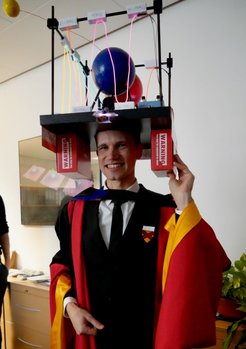Vitaly Wirthl: Exploring ‘new physics’ in deuterium
The scientist from the Laser Spectroscopy division achieved unprecedented precision in measuring an energy transition in heavy hydrogen.
In his PhD project, Vitaly Wirthl investigated a previously unknown electronic transition in heavy hydrogen, also known as deuterium. The experimental physicist showed that the transitions between different energy levels in deuterium can be measured with a similar precision as in ordinary hydrogen atoms. Ultra-precise measurements of atoms enable a direct comparison with the theory of quantum electrodynamics - necessary for the exact determination of the constants of nature, but also for testing the theory: discrepancies between theory and experiment can provide indications of "new physics", which may be connected to ‘dark matter’ or ‘dark energy’, which have been little known until now.

Our understanding of nature remains incomplete: we can only make reliable statements about around five per cent of the universe - namely visible matter, i.e. protons, neutrons and electrons. The composition of the rest, so-called ‘dark matter’ and ‘dark energy’, remains an enigma. Scientists suspect the existence of a ‘new physics’ that either describes previously unknown particles or modifies known laws of nature so that they can be brought in agreement with observations. And this is where precision spectroscopy comes into play: ultra-precise measurements of atoms can be compared with the underlying theory of quantum electrodynamics (QED), the basis for our fundamental physics today. This allows us to measure the natural constants that are used as parameters in the theory. Once a sufficient number of measurements is available, the theory itself can be tested or verified. If the measurements deviate from the theoretical calculations, researchers may be able to derive new insights into the laws of nature from these discrepancies.
Hydrogen-like systems are particularly suitable for precision measurements, as the simple structure of these atoms allows for reliable calculations. In his work, Vitaly Wirthl focused on the heavy hydrogen atom, also known as deuterium. Unlike ordinary hydrogen, atomic deuterium has a composite nucleus. Due to the hyperfine structure arising from the coupling of the angular momenta of the nucleus and the electron, the structure of energy levels is more complex than in ordinary hydrogen. However, the scientist demonstrated that the 2S-6P transition in deuterium—one of several electronic transitions that have never been precisely measured —can be determined just as reliably as in ordinary hydrogen, i.e. with an accuracy of twelve decimal places.
To enable a measurement of this precision, the researcher developed a technique to suppress the so-called Doppler shift. The main element of the system is the active fibre-based retroreflector (AFR), which is also used in measurements of simple hydrogen. By improving the fibre collimator responsible for generating high-quality counter-propagating laser beams, Vitaly succeeded in precisely measuring the 2S-6P transition in deuterium for the first time. Vitaly Wirthl's work thus provides an important foundation for future precision measurements, aiming to test the QED theory in deuterium with an accuracy of 12 decimal places, and potentially advancing the search for 'new physics’.
“Even in Harvard you normally don‘t have this kind of service“
What’s next?
Vitaly Wirthl continues his research as a postdoctoral researcher in the Laser Spectroscopy division: “Precision experiments usually take longer than a PhD, and I really appreciate the excellent scientific atmosphere here at MPQ," Vitaly explains. He is also grateful and impressed by the support from the precision mechanics and technicians, who relieve the scientists of a lot of work: "Even at Harvard, you don't normally have this kind of service. There, you usually have to build every little thing yourself in the workshop."












